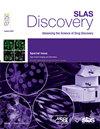MT1G activation in dopaminergic neurons identifies chelators and their relationships to cytotoxicity
IF 2.7
4区 生物学
Q2 BIOCHEMICAL RESEARCH METHODS
引用次数: 0
Abstract
Although multiple pesticides and solvents are risk factors for Parkinson’s disease [1] and other neurodegenerative diseases, most risk factors remain undiscovered. We previously identified the metallothionein gene MT1G as a biomarker for neurotoxicity induced by all seven neurotoxicants tested in LUHMES dopaminergic neurons. Here we used CRISP/R technology to insert a HiBiT tag into the MT1G gene of the LUHMES cell line. The engineered LUHMES MT1G::HiBiT cell lines were used to develop a quantitative high throughput screening [2] assay in a 3D-suspension culture platform with 1536 well microplates. We validated this qHTS assay by screening the LOPAC (Library of Pharmacologically Active Compounds) collection composed of 1280 compounds plus 88 selected Tox21 chemicals, demonstrating high signal-to-noise and reproducibility. In screening this library, 49 compounds were confirmed to significantly increase MT1G-HiBiT activity, including 35 compounds that exhibited cytotoxicity below 50 μM, and 14 noncytotoxic compounds. Most of these MT1G-HiBiT inducers killed cells at concentrations moderately higher than their MT1G-HiBiT activation potencies (AC50), however 14 showed MT1G-HiBiT AC50 values more than 3-fold lower than cytotoxicity IC50 values, and two showed higher values. Among the 49 MT1G-HiBiT inducers, 45 compounds resembled chelators. To test this apparent association, 27 known chelators were gathered and tested. Of these, 23 were active in the MT1G-HiBiT activity assay, confirming the propensity of chelators to activate MT1G transcription. Screening chemical libraries with this validated assay and characterizing the effects of active chemicals on cultured neurons may enable the identification of neurotoxicants or neurotoxic chemotypes that may cause neurodegenerative diseases.
多巴胺能神经元MT1G激活鉴定螯合剂及其与细胞毒性的关系。
虽然多种农药和溶剂是帕金森病[1]和其他神经退行性疾病的危险因素,但大多数危险因素仍未被发现。我们之前确定金属硫蛋白基因MT1G是LUHMES多巴胺能神经元中所有7种神经毒物诱导的神经毒性的生物标志物。我们使用CRISP/R技术将HiBiT标签插入到LUHMES细胞系的MT1G基因中。利用LUHMES MT1G::HiBiT细胞系在1536孔微孔板的3d悬浮培养平台上进行定量高通量筛选[2]实验。我们通过筛选LOPAC(药理学活性化合物库)收集的1280种化合物和88种选定的Tox21化学物质来验证该qHTS方法,显示出高信噪比和重复性。在筛选该文库时,49个化合物被证实显著提高MT1G-HiBiT活性,其中35个化合物表现出50 μM以下的细胞毒性,14个化合物表现出非细胞毒性。大多数MT1G-HiBiT诱导剂在浓度高于其MT1G-HiBiT激活能力(AC50)时杀死细胞,但有14种MT1G-HiBiT诱导剂的AC50值低于细胞毒性IC50值的3倍以上,有2种诱导剂的AC50值高于细胞毒性IC50值。在49个MT1G-HiBiT诱导剂中,45个化合物与螯合剂相似。为了验证这种明显的联系,收集并测试了27种已知的螯合剂。其中,23个在MT1G- hibit活性测定中具有活性,证实了螯合剂激活MT1G转录的倾向。筛选化学文库与这种验证试验和表征活性化学物质对培养的神经元的影响可能使识别神经毒物或神经毒性化学型,可能导致神经退行性疾病。
本文章由计算机程序翻译,如有差异,请以英文原文为准。
求助全文
约1分钟内获得全文
求助全文
来源期刊

SLAS Discovery
Chemistry-Analytical Chemistry
CiteScore
7.00
自引率
3.20%
发文量
58
审稿时长
39 days
期刊介绍:
Advancing Life Sciences R&D: SLAS Discovery reports how scientists develop and utilize novel technologies and/or approaches to provide and characterize chemical and biological tools to understand and treat human disease.
SLAS Discovery is a peer-reviewed journal that publishes scientific reports that enable and improve target validation, evaluate current drug discovery technologies, provide novel research tools, and incorporate research approaches that enhance depth of knowledge and drug discovery success.
SLAS Discovery emphasizes scientific and technical advances in target identification/validation (including chemical probes, RNA silencing, gene editing technologies); biomarker discovery; assay development; virtual, medium- or high-throughput screening (biochemical and biological, biophysical, phenotypic, toxicological, ADME); lead generation/optimization; chemical biology; and informatics (data analysis, image analysis, statistics, bio- and chemo-informatics). Review articles on target biology, new paradigms in drug discovery and advances in drug discovery technologies.
SLAS Discovery is of particular interest to those involved in analytical chemistry, applied microbiology, automation, biochemistry, bioengineering, biomedical optics, biotechnology, bioinformatics, cell biology, DNA science and technology, genetics, information technology, medicinal chemistry, molecular biology, natural products chemistry, organic chemistry, pharmacology, spectroscopy, and toxicology.
SLAS Discovery is a member of the Committee on Publication Ethics (COPE) and was published previously (1996-2016) as the Journal of Biomolecular Screening (JBS).
 求助内容:
求助内容: 应助结果提醒方式:
应助结果提醒方式:


